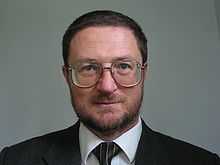Andrei Knyazev (mathematician)
| Andrei (Andrew) Knyazev | |
|---|---|
 Andrew Knyazev | |
| Born |
June 9, 1959 Moscow, Soviet Union |
| Fields | Numerical analysis, Applied Mathematics, Computer Science |
| Institutions |
Kurchatov Institute Institute of Numerical Mathematics RAS University of Colorado Denver Mitsubishi Electric Research Laboratories |
| Alma mater | Moscow State University |
| Doctoral advisor | Vyacheslav Ivanovich Lebedev |
| Doctoral students | see Andrei Knyazev at the Mathematics Genealogy Project |
| Known for | eigenvalue solvers |
| Notable awards | IEEE Senior Member (2013) |
Andrei (Andrew) Knyazev (Russian: Андрей Владимирович Князев) is a Russian-American mathematician. He graduated from the Faculty of Computational Mathematics and Cybernetics of Moscow State University under the supervision of Evgenii Georgievich D'yakonov (Russian: Евгений Георгиевич Дъяконов) in 1981 and obtained his PhD in Numerical Mathematics at the Russian Academy of Sciences under the supervision of Vyacheslav Ivanovich Lebedev (Russian: Вячеслав Иванович Лебедев) in 1985. He worked at the Kurchatov Institute in 1981-1983, and then to 1992 at the Institute of Numerical Mathematics (Russian: ru:Институт вычислительной математики РАН) of the Russian Academy of Sciences, headed by Gury Marchuk (Russian: Гурий Иванович Марчук).
In 1993-1994, he held a visiting position at the Courant Institute of Mathematical Sciences of New York University, collaborating with Olof B. Widlund.[1] From 1994 until retirement in 2014, he was a Professor of Mathematics at the University of Colorado Denver, supported by the National Science Foundation[2] and United States Department of Energy grants. In 2012, he took a research position at the Mitsubishi Electric Research Laboratories.[3]
Knyazev was mostly known for his work in numerical solution of large sparse eigenvalue problems, particularly the iterative method LOBPCG.[4] An implementation of LOBPCG was available in the public software package BLOPEX. A popular public electronic structure calculations package ABINIT used LOBPCG for wavefunction parallel optimization.[5][6]
Knyazev collaborated with John Osborn [7] on the theory of the Rayleigh–Ritz method (see also [8]) and with Nikolai Sergeevich Bakhvalov (Russian: Николай Серге́евич Бахвалов) on numerical solution of elliptic partial differential equations (PDE's) with large jumps in the main coefficients.[9] His Erdős number = 4.
References
- ↑ Knyazev, Andrew; Widlund, Olof (2003), "Lavrentiev Regularization + Ritz Approximation = Uniform Finite Element Error Estimates for Differential Equations with Rough Coefficients", Mathematics of Computation 72: 17–40, doi:10.1090/S0025-5718-01-01378-3
- ↑ Knyazev's NSF awards
- ↑ Andrew Knyazev moved to MERL, 2012
- ↑ Knyazev, A.V. (2001), "Toward the Optimal Preconditioned Eigensolver: Locally Optimal Block Preconditioned Conjugate Gradient Method", SIAM Journal on Scientific Computing 23 (2): 517–541, doi:10.1137/S1064827500366124
- ↑ wfoptalg variable ABINIT ver. 7.0
- ↑ Bottin, F.; Leroux, S.; Knyazev, A.; Zerah, G. (2008), "Large scale ab initio calculations based on three levels of parallelization", Computational Material Science 42 (2): 329–336, doi:10.1016/j.commatsci.2007.07.019
- ↑ Knyazev, A.V.; Osborn, J. (2006), "New A Priori FEM Error Estimates for Eigenvalues", SIAM. J. Num. Anal. 43 (6): 2647–2667, doi:10.1137/040613044
- ↑ Knyazev, A.V.; Argentati, M.E. (2010), "Rayleigh–Ritz majorization error bounds with applications to FEM", SIAM. J. Matrix Anal. & Appl 31 (3): 1521–1537, doi:10.1137/08072574X
- ↑ Bakhvalov, N.S.; Knyazev, A.V.; Parashkevov, R.R. (2002), "Extension Theorems for Stokes and Lamé equations for nearly incompressible media and their applications to numerical solution of problems with highly discontinuous coefficients", Numerical Linear Algebra with Applications 2 (2): 115–139, doi:10.1002/nla.259
External links
- Knyazev at arXiv
- Knyazev at ResearcherID
- Andrei Knyazev's publications indexed by Google Scholar, a free service provided by Google
- Knyazev at MathSciNet
- Knyazev at Zentralblatt MATH
- Andrei Knyazev at the Mathematics Genealogy Project
- Block Locally Optimal Preconditioned Eigenvalue Xolvers (BLOPEX)
- Knyazev's software in MATLAB
- Website at the University of Colorado Denver
- Website at the Mitsubishi Electric Research Laboratories